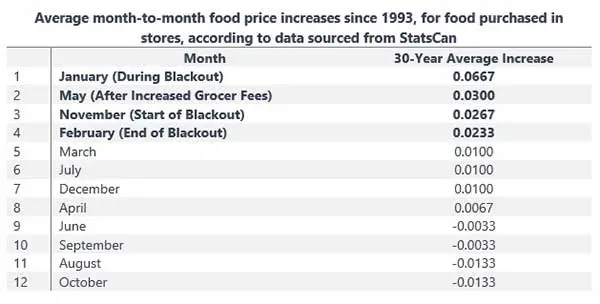From farmland protection scandals to gene editing and milk dumping, here’s what made headlines in the food industry this year
Sylvain Charlebois, Troy Media
As we approach the end of 2023, it’s always interesting to reflect on the year that was. Selecting the top story from our list of the year’s top 10 food news stories presented a challenge, primarily due to the pervasive coverage of food inflation, which made headlines for both favourable and less favourable reasons.
Given the overarching theme of rising food prices, this list is composed of stories linked to or triggered by these price increases. Furthermore, while issues related to weather and climate change remained paramount, I opted not to incorporate them into this year’s top 10, as they exert a substantial and enduring impact on the agri-food industry year after year.
Here are this year’s top food news stories:
10) The Greenbelt scandal
In 2023, farmland protection became a headline across the country for the first time in many years. The Ford government was accused of allowing private developers to influence the Ontario government’s decision to allow some protected land to be used for new housing districts. After several investigations and a few cabinet ministers’ resignations, the Ford government reversed its plan to open the protected Greenbelt lands for housing development and committed to no further changes to the Greenbelt in the future. It was fascinating to see farmland management take the forefront this year, emerging as a significant political issue in Canada’s largest province.
9) Grocer code of conduct announced
It was both surprising and refreshing to witness the prominence of the code of conduct, a rather unsexy topic, making repeated headlines this year. Federal Minister of Innovation, Science, and Industry François-Philippe Champagne championed Ottawa’s efforts to achieve greater stability in food prices this year, ultimately determining that a code of conduct for grocers is the most effective solution to enhance competition within Canada’s food retail and manufacturing sectors. The implementation of such a code was announced this year. The United Kingdom, Ireland, and Australia already have similar codes that have proven to stabilize food retail prices and provide more variety for consumers.
While there is widespread consensus on the necessity of a code of conduct in Canada, the debate persists regarding whether it should be mandatory. Both Loblaw and Walmart Canada object to a compulsory code, and some argue that, without universal participation, the code will be ineffective.
8) Milk dumping viral video and baby formula shortages
A video of an exasperated Canadian dairy farmer, Jerry Huigen, went viral this year. For perhaps the first time in Canadian history, a Canadian dairy farmer was filmed discarding milk on his farm. The video garnered millions of views and shocked many Canadians, who questioned why such wastage occurred when food prices were soaring in grocery stores. Some reports suggested that millions of litres of milk are dumped every year, but the Dairy Farmers of Canada have consistently denied the issue, labelling Huigen’s video as an isolated incident.
Meanwhile, Canada continued to experience baby formula shortages throughout the year, leaving many parents puzzled about the scarcity of products when milk dumping seemed to be a recurring problem. To add to the confusion, Ontario-based Canada Royal Milk, a Chinese-owned dairy processing plant, is Canada’s sole baby formula plant, yet little is known about its operations.
7) Gene editing approved in Canada
Ottawa’s environmental approval of gene editing is possibly the most significant news in Canadian agriculture this year. Gene editing in food refers to the use of techniques such as CRISPR to modify the DNA of plants, animals, or microorganisms used in food production. Unlike GMOs, which involve inserting foreign genetic material from a different species into an organism’s genome, gene editing allows scientists to make specific changes to an organism’s genome, potentially improving its nutritional value, disease resistance, or other desirable traits. Gene editing will create crops that are more resilient to pests, diseases, and environmental stresses, and can enhance their flavour, appearance, or shelf life.
Gene editing is expected to play a crucial role in helping agriculture and farmers adapt to climate change.
6) Lab-grown meat approved in the U.S.
A significant milestone has been achieved in the cultured meat industry, with the United States Department of Agriculture (USDA) granting regulatory approval to GOOD Meat and UPSIDE Foods for the commercial distribution of their cultivated chicken products within the country. The U.S. has become the second country this year to permit the commercialization of cultivated meat. Cultivated meat, also known as cultured meat, refers to meat-based products produced from animal cells cultured in a laboratory, offering a potential solution to the environmental and ethical challenges associated with traditional meat consumption.
In Canada, the regulatory framework is more complex, primarily due to the supply management regime governing the production of dairy, poultry, and eggs. Canada is expected to lag in cultivated meat regulatory approvals, but this year’s U.S. approval has added more pressure.
5) Record-breaking fine in bread pricing scandal
For the first time in nearly six years, there has been significant progress in the investigation of price-fixing within the bread market, which was launched back in 2015. Canada Bread, currently owned by Mexico-based Grupo Bimbo, acknowledged its culpability in two distinct incidents of price-fixing in 2007 and 2011, even though Canada Bread was owned by Maple Leaf Foods at the time.
Consequently, the Mexican group agreed to pay a fine of $50 million, marking the highest penalty ever imposed in Canada for price-fixing. Loblaws and Weston Bakeries had previously confessed to their involvement in the bread scandal: Loblaws extended an apology to all Canadians in the form of a $25 gift card in 2017 without being required to pay a fine. As of this year, four companies are still under investigation, even after eight years: Sobeys, Metro, Walmart Canada, and Giant Tiger.
4) Shrinkflation and skimpflation
Consumers were not only concerned about higher food prices but also annoyed by the food industry’s tactics to maintain prices while reducing quantities or changing ingredients. Shrinkflation occurs when food manufacturers and restaurants reduce quantities without lowering prices. Canada’s famous Kraft Mac and Cheese was the most well-known case this year, which upset many consumers. Skimpflation involves manufacturers changing product ingredients to cut costs, often replacing chocolate and cheese with artificial ingredients.
While the number of shrinkflation cases is expected to decrease due to lower commodity prices in 2024, more skimpflation cases are anticipated due to front-of-package labelling rules set to be introduced in Canada in 2026.
3) High-profile strikes in the food industry
When a labour dispute occurs in the food industry, it doesn’t take long to impact consumers. Windsor Salt, Sobeys, Metro, Olymel, The Rogers Sugar plant in Vancouver, the St. Lawrence Seaway, British Columbia Ports, and Agropur were affected by labour disputes. Although the number of work stoppages in Canada was not as high as in previous years, many strikes this year had longer durations, according to Economic and Social Development Canada.
After years of decline, organized labour seems to have gained more political capital and used it to its advantage this year. Interestingly, there was an increase in members rejecting tentative agreements, indicating that workers wanted their voices heard.
2) Competing necessities of life: shelter and food
Something unusual occurred this year, particularly between April and September. Despite higher food prices, Canadians were spending less on food than the previous year. The average Canadian spent about two to four percent less on food for a significant portion of 2023, surprising many. Canadians traded down on food because trading down on shelter was much more challenging. The Bank of Canada raised its benchmark interest rate 10 times in a row, catching many Canadian households off guard and forcing them to allocate more funds to housing costs.
While food prices presented a challenge, housing costs likely compelled many to make unwanted nutritional compromises this year.
1) The profiteering blame-game
Throughout the year, Canadians found themselves puzzled by the ongoing blame game. Some politicians, interest groups, and experts repeatedly used allegations of profiteering as a diversion from more substantial economic issues such as interprovincial barriers, carbon pricing, and Bill C-234. Despite statements from the Bank of Canada, the Competition Bureau of Canada, Dalhousie University, and even the Parliamentary Committee asserting no evidence of profiteering, many Canadians remained unconvinced.
The politicization of food inflation in Canada this year was marked by intense debates, often tainted by personal attacks and accusations of bias from various sides. In contrast, within the industry, food manufacturers and grocers blamed each other for higher food prices. This profiteering narrative is likely the biggest non-scandal of the year, exacerbating the plight of Canadians.
There you have it. My top 10 food stories for 2023.
Dr. Sylvain Charlebois is senior director of the agri-food analytics lab and a professor in food distribution and policy at Dalhousie University.




